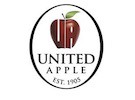Last year’s domestic apple crop is a tale of two seasons as weather conditions in major growing regions dictated significantly different results for orchards in the Northwest and Northeast.
The extreme heat in late summer and overall challenging weather conditions in Washington caused a 20 percent drop in volume to a 100 million case crop. This shortfall created supply challenges for retailers who typically rely heavily on fruit from the country’s largest apple-growing region.
On the other side of the country, the New York apple crop reported a strong 32+ million bushel volume, with good sizing, high color and excellent flavor. Basically a rebound year from the previous harvest, the eastern region experienced near record volume with traditional varieties including Acey Mack, Empire, Fuji, Gala, Pink Lady and Red Delicious.
 Left to right: Brett Baker, Josh Tunstall
Left to right: Brett Baker, Josh Tunstall
Brett Baker, a fourth-generation orchardist and an owner of integrated grower/ packer United Apple Sales in western New York indicated the conditions were favorable in the summer and straight through to the end of harvest.
“We're constantly analyzing data and using smart technology to balance what Mother Nature provides and augmenting with the right nutrients to fit the respective needs of each variety,” he says. “The old regimen of using the same strategy across all blocks is long gone. We now operate with prescription farming practices where each variety--in some cases each block--warrants a customized plan recognizing the age of the orchard, the respective maturity of the trees and the anticipated market demand for sizing and volume. The customized growing strategies along with our investment in new storage technologies have helped us extend the season and enhance fruit quality.”
He also attributed United Apple's success to its network of 59 local growers with managed club varieties: EverCrisp, Ruby Frost and SnapDragon.
Baker indicated that EverCrisp is in its fifth season with the product projected to be available through May. SnapDragon is in season nine with volume until late March. Ruby Frost is in its ninth season with product into June.
With Washington’s crop being down, United Apple has reached out to its Southern hemisphere import partners to support requested volumes for slicers and processors to build consistent volumes for national programs.
“After industry-wide issues with the supply chain last year, we are working with our partners to negotiate favorable pricing on fruit and freight costs, which have declined from record rates last season. We can deliver imported product to both east and west coast ports,” says Josh Tunstall, vice president of Northwest sales and operations.
Import arrivals are scheduled as:
- Gala: late March through mid-July;
- Grannies: mid-April through mid-August;
- Fuji: mid-May through late August;
- Pink Lady: mid-May through early September.
 For more information:
For more information:
Bob Solberg
United Apple
Tel: +1 612-916-0187
+1 (585) 765-2460 (sales)
bsolberg@comcast.net
https://unitedapplesales.com/
